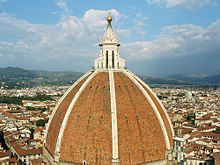Egg of Columbus
The Egg of Columbus is a phrase that describes a surprisingly simple solution to a seemingly unsolvable problem. The Gordian knot has a similar meaning .
origin
The origin of the expression should be based on an anecdote that is told something like this:
- After his return from America, during a meal with Cardinal Mendoza in 1493 , Christopher Columbus is accused that it was easy to discover the “ New World ”, as anyone else could have done this too. Columbus then asks those present to place a boiled egg on the top. Many attempts are made, but no one manages to accomplish this task. After all, it is believed that this is an impossible task, and Columbus is asked to try it himself. He hits his egg with the tip on the table so that it is slightly pressed in and the egg stays there. When those present protested that they could have done it too, Columbus replied: "The difference is, gentlemen, that you could have done it, but I did it!"

Originally, the anecdote about Columbus' egg was coined by the Italian artist Giorgio Vasari (1511–1574) on his compatriot Filippo Brunelleschi (1377–1446). This builder is said to have received the order to build the dome of the Cathedral of Santa Maria del Fiore by solving the "egg problem" . That would certainly make the anecdote appropriate, since the dome of the cathedral in Florence is evidently reminiscent of the shape of an egg that has been pushed open at the top.
The connection with Columbus goes back to Girolamo Benzoni , who tells the anecdote in his work on the history of the New World ( Historia del mondo nuovo , Venice 1565) in the Columbus version, but admits that he only knew the matter from hearsay .
In South America, a version is widespread according to which Columbus did not press the egg, but put it in heaped salt.
various
Although common in many European languages, the expression seems to be unknown in English, or at least not in common use.
In F. Scott Fitzgerald's novel The Great Gatsby , however, the “Egg of Columbus” is mentioned as follows: “Twenty miles from the city a pair of enormous eggs, identical in contour and separated only by a courtesy bay […] They are not perfect ovals - like the egg in the Columbus story, they are both crushed flat at the contact end […] “(Eng. 20 miles away from the city [stand] two enormous eggs, identical in shape and separated from only one Politeness distance [...] They are not perfectly egg-shaped, but like in the story about the egg of Columbus, they are indented at the touching end [...] )
The egg of Columbus is also mentioned in Mary Shelley's preface to Frankenstein : “Invention […] does not consist in creating out of void, but out of chaos. [...] In all matters of discovery and invention, even of those that appertain to the imagination, we are continually reminded of the story of Columbus and his egg. "
Paul Auster also mentions the egg of Columbus in his novel City of Glass (New York Trilogy, page 113).
On the occasion of the Columbian World Exhibition on the 400th anniversary of the discovery of America, Nikola Tesla developed an induction motor for the Westinghouse Electric booth , the rotor of which is made of a metal. Thanks to the rapid rotation, the egg can stand on the top like a top without the “trick of Columbus”. The experiment can now be viewed in Belgrade's Tesla Museum.
In Seville there is a 45 meter high Columbus monument called Huevo de Colón (“Egg of Columbus”).
The expression has also found use in the book title Columbus eggs , in which many tricks , sleight of hand and experiments for entertainment are described.
literature
- Andreas Venzke : The discoverer of America - rise and fall of Christopher Columbus. Zurich 1991, ISBN 3-545-34091-0 .
Web links
Individual evidence
- ↑ Naoshi Fukushima: Columbus' Egg. In: Bulletin d'Information No. 71. Bureau Gravimetrique International, Toulouse 1992, pp. 113-116.
- ^ Mary Shelley: Frankenstein. In: Four Gothic Novels. Oxford University Press, Oxford 1994, p. 455.
- ↑ Google Maps: Huevo de Colón
- ^ Edi Lanners: Columbus Eggs - Tricks - Games - Experiments , Verlag CJ Bucher, Lucerne and Frankfurt / Main 1976, ISBN 3-7658-0220-4 .
